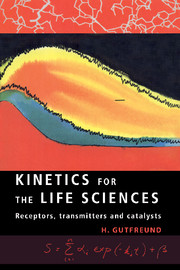Book contents
- Frontmatter
- Contents
- Preface
- 1 The time scales of nature: a historical survey
- 2 Some mathematical introductions
- 3 Elementary kinetic equations: ground rules
- 4 Kinetic analysis of complex reactions
- 5 Transient kinetics of enzyme reactions
- 6 Chemical relaxation phenomena
- 7 Factors affecting rates of reactions
- 8 The role of light in kinetic investigations
- References
- Index
1 - The time scales of nature: a historical survey
Published online by Cambridge University Press: 08 January 2010
- Frontmatter
- Contents
- Preface
- 1 The time scales of nature: a historical survey
- 2 Some mathematical introductions
- 3 Elementary kinetic equations: ground rules
- 4 Kinetic analysis of complex reactions
- 5 Transient kinetics of enzyme reactions
- 6 Chemical relaxation phenomena
- 7 Factors affecting rates of reactions
- 8 The role of light in kinetic investigations
- References
- Index
Summary
The history of the application of physical principles
Input into biophysics from physics and biology
It is of interest to consider the historical development of ideas on the formal description and interpretation of chemical kinetics and the contributions made to this field by those with an interest in biological problems. In recent years we have witnessed a return to a multi-disciplinary approach in which more physical scientists are becoming involved in the study of biology. However, it is worth noting that this has been a recurrent feature of this field throughout history. In the eighteenth and nineteenth centuries it was easier to be a polymath than it is today. An outstanding example was Hermann von Helmholtz (1821–1894) who started his professional life as an army medical officer and held in succession chairs of anatomy, physiology and physics. In 1871 he was offered, but declined, the world's most coveted post in physics, the Cavendish Professorship in Cambridge. He developed a most ingenious method for measuring the rates of muscle contraction and the conduction of signals in nerve fibres (Helmholtz, 1850). The design and detailed description of these experiments are well worthy of study 150 years later. At that time he was also involved in establishing that the laws of conservation of energy applied to metabolic processes and physiological functions. His further important contributions were in the physics of vision (Helmholtz, 1856) and of hearing (republished Helmholtz, 1954). Last, but not least, he was associated with the theoretical physicist J. Willard Gibbs (1839–1903) in formulating some of the most important laws in chemical thermodynamics and electrochemistry.
- Type
- Chapter
- Information
- Kinetics for the Life SciencesReceptors, Transmitters and Catalysts, pp. 1 - 18Publisher: Cambridge University PressPrint publication year: 1995



